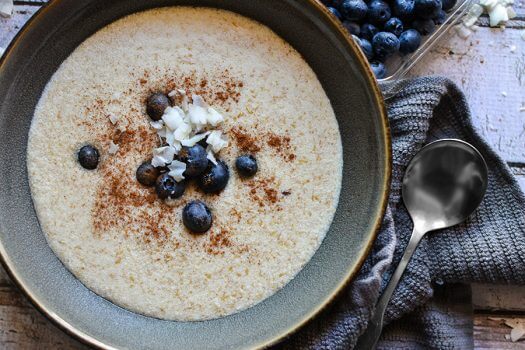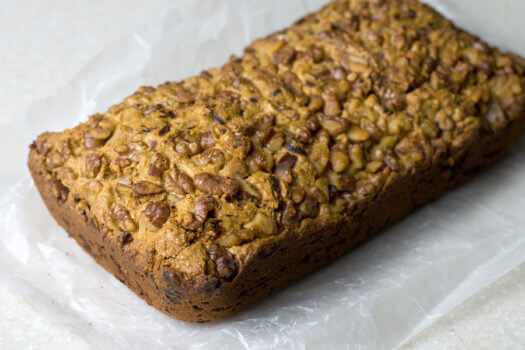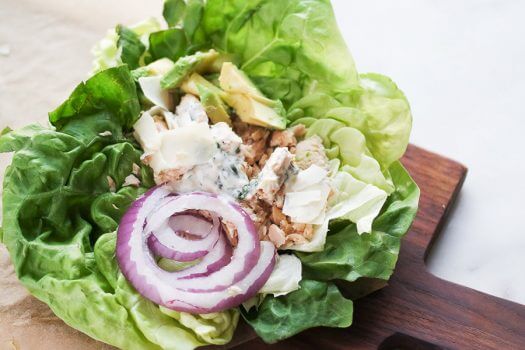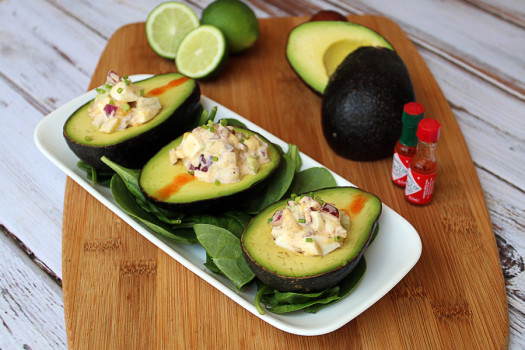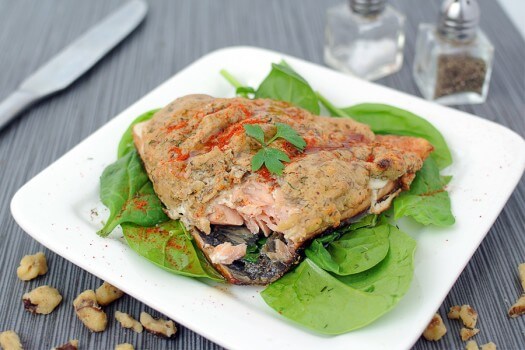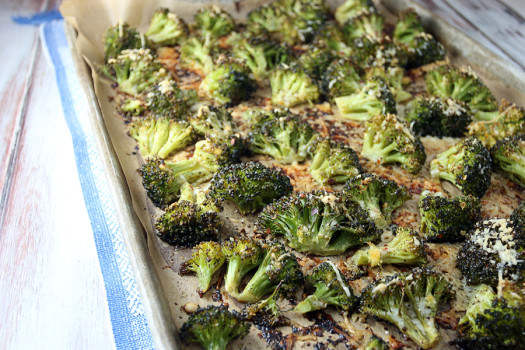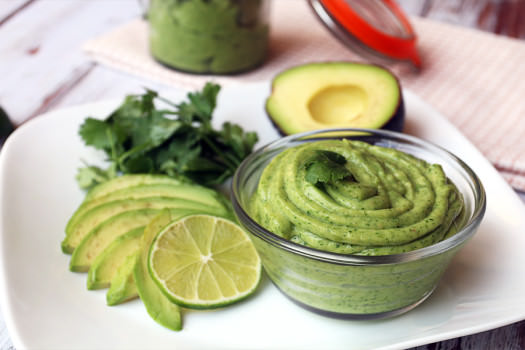The Mediterranean diet is widely recognized as being one of the best diets for weight loss and overall health. When compared to a typical western diet filled with processed foods, this plant-based diet is a safe, effective, and reliable bet.
However, conservative approaches typically yield moderate results. In contrast, radically unconventional diets have a greater potential to make significant changes — changes that may come with an increased health risk for some.
The keto diet is the perfect example of this, with a plethora of research backing the substantial impact this uncommon approach has on several conditions ranging from diabetes and obesity to neurological disorders like Alzheimer’s disease, Parkinson’s disease, and epilepsy. However, there are small subsets of the population that may worsen their health by following a low-carb, high-fat diet like keto.
Long story short, the Mediterranean diet and the keto diet both have significant advantages under different contexts. When we combine them into one diet, however, most of their downsides melt away, leaving us with a way of eating that can significantly improve every aspect of health.
Before we take a closer look at the Mediterranean keto diet, let’s uncover the foundational principles of each diet first. This will equip you with some of the dietary knowledge you need to meet your goals more effectively.
Feel free to use this clickable table of contents to find the information you are looking for:
- What is the Mediterranean Diet?
- What is the Keto Diet?
- Keto Vs. Mediterranean Diet: The Similarities
- Keto Vs. Mediterranean Diet: The Differences
- Keto Vs. Mediterranean Diet: Key Takeaways
- The Case for the Ketogenic Mediterranean Diet: Science-backed Benefits
- What is the Ketogenic Mediterranean Diet?
- Keto Mediterranean Diet Food List
- Keto Mediterranean Diet Recipes
- Keto Mediterranean Diet Meal Plan
- Who Would Benefit/Least Most from This Diet?
- Putting It All Together: The Diet, Its Benefits, and Practical Suggestions
What is the Mediterranean Diet?
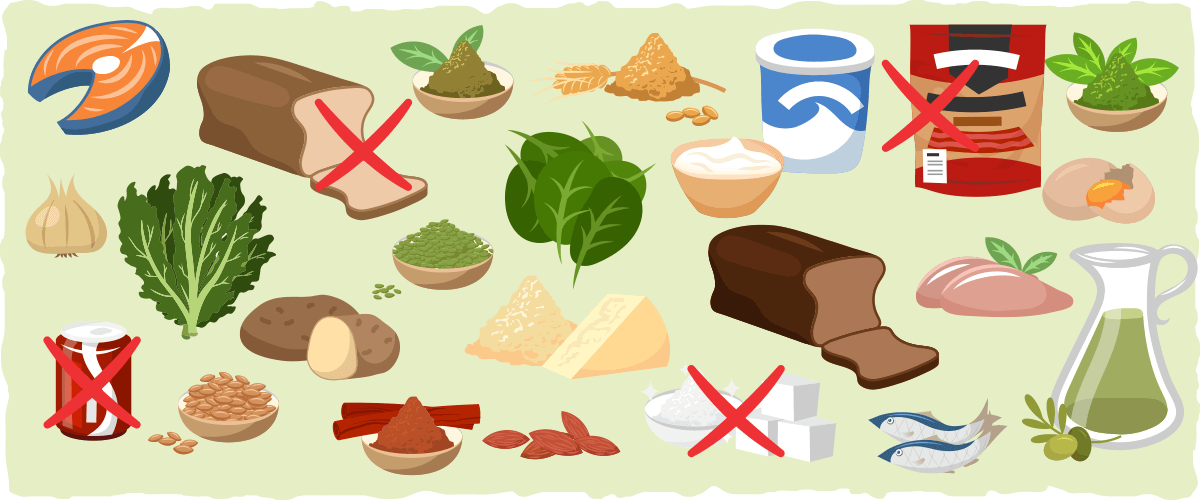
The Mediterranean diet has been the subject of intensive research for more than 50 years. Its rise in popularity began after Ancel Keys, PhD, a professor from the University of Minnesota, published the Seven Countries Study.
This study examined the health outcomes of nearly 13,000 middle-aged men in the United States, Japan, Italy, Greece, the Netherlands, Finland, and then-Yugoslavia. His team found that men from Crete — a large island in the Mediterranean sea — experienced lower heart disease rates than their counterparts in other countries. Keys et. al. concluded that this result is linked to the men’s post-World War II “poor” diet, which focused on fruits, vegetables, grains, beans, and fish .
Since Keys’ first observation decades ago, hundreds of studies have documented an array of health benefits linked with the “traditional” Mediterranean diet. These benefits include:
- increased life span
- lower risks of certain cancers, heart disease, Alzheimer’s disease, and type 2 diabetes
- reduced mortality risk from stroke and heart attack
- reduced incidence of stroke and heart attack
- improved body composition
- enhanced brain function
- lower levels of blood pressure and LDL cholesterol
The traditional Mediterranean diet — i.e., what is typically used in studies examining the Mediterranean diet — consists of 50%–60% of daily calories from carbohydrates, 25%–35% of calories from fat (with a heavy emphasis on natural unsaturated fats), and the remainder from protein.
Common staples of the Mediterranean diet are as follows:
- Vegetables
- Fruits
- Nuts
- Seeds
- Legumes
- Potatoes
- Whole grains
- Bread
- Herbs & spices
- Fish & seafood
- Olive oil
Cheese, poultry, eggs, and yogurt are also a part of the diet in moderation. Typically, red meat is rarely consumed, and sugar-sweetened beverages, added sugars, processed meat, refined grains, refined oils, and other highly processed foods are avoided.
Because of its relatively simple concept and the abundance of research supporting its benefits, the Mediterranean diet is typically ranked as one of the best diets for health and weight loss by multiple publications.
This approach to eating, however, is not a magic bullet. It may be a safe bet for general health improvement, but research suggests that other diets can have a much more profound impact on specific aspects of health. The keto diet, for example, has been found to improve several common health conditions in a way that the traditional Mediterranean diet cannot match.
What is the Keto Diet?
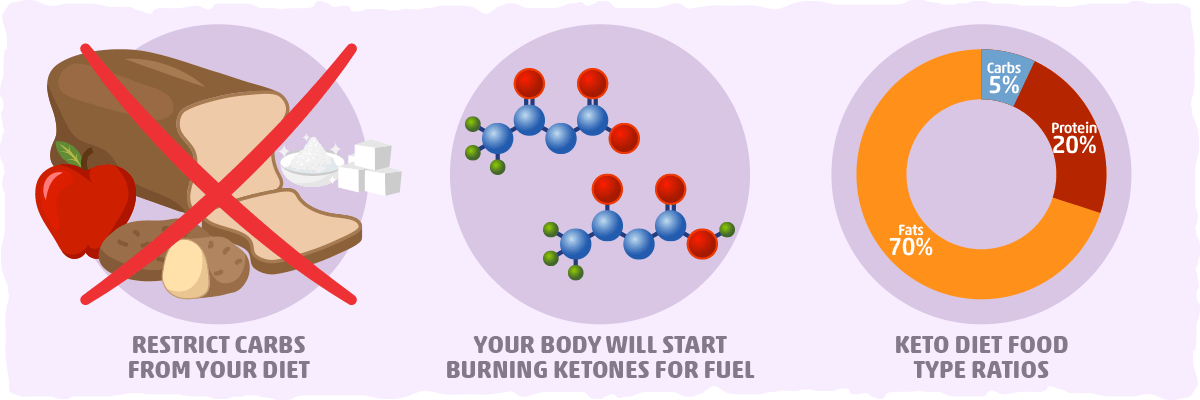
The keto diet can be defined in many different ways, but it is most commonly described as being a high-fat, low-carb, low-to-moderate protein diet initially used as a treatment for some cases of epilepsy in the early 1900s. However, phrases like “high-fat” and “low-carb” are so vague that they don’t encapsulate what differentiates a keto diet from any other low carb diet.
The simplest way I’ve found to conceptualize the keto diet is this: If you restrict carbs to the point that you enter and sustain ketosis with your diet, you are on keto. It’s that straightforward but requires a bit of background knowledge to understand the concept.
Ketosis is a metabolic state in which your body is consistently using and burning a highly efficient alternative fuel called ketones. To produce ketones and enter ketosis, we must continually trigger a process in the liver called ketogenesis. The healthiest way to do this is by limiting carb consumption more than other common low carb diets.
This is why this version of the low carb diet is called the “ketogenic diet” — Its primary objective is to limit carbs to the point that you stimulate ketogenesis and enter nutritional ketosis.
To achieve this unique metabolic state, you must avoid these high-carb foods:
- Grains – wheat, corn, rice, cereal, etc.
- Sugar – honey, agave, maple syrup, etc.
- Fruit – apples, bananas, oranges, etc.
- Tubers – potato, yams, etc.
And get most of your calories from these healthy high-fat foods:
- Meats – fish, beef, lamb, poultry, eggs, etc.
- Low-carb vegetables – spinach, kale, broccoli, and other low carb veggies >
- High-fat dairy – hard cheeses, high fat cream, butter, etc.
- Nuts and seeds – macadamias, walnuts, sunflower seeds, etc.
- Avocado and berries – raspberries, blackberries, and other low glycemic impact berries
- Sweeteners – stevia, erythritol, monk fruit, and other low-carb sweeteners >
- Other fats – coconut oil, high-fat salad dressing, saturated fats, etc.
It is also essential to make sure you are eating around 70% fats, 25% protein, and 5% carbohydrate. When carb and/or protein consumption are too high, ketone production will be impaired.
Although there hasn’t been as much research on the keto diet as there has been on the Mediterranean diet, The current data suggests that the diet can have a profound impact on our health including:
- Remarkable decreases in insulin, blood sugar, and hbA1c levels
- Significant reductions in triglyceride levels
- Optimization of blood cholesterol levels via increasing HDL and improving LDL particle stability
- Significant reductions in blood pressure
- Reducing the severity of type 2 diabetes, fatty liver disease, PCOS, certain types of cancer and neurological disorders including epilepsy, Alzheimer’s disease, and Parkinson’s disease
- Substantial increases in fat loss
Despite the proven upsides of the keto diet, there are some potential downsides, commonly emphasized in the public media. The main keto criticism is that the increased saturated fat content of the keto diet will significantly increase cholesterol levels and heart disease risk.
Although this may occur for a small subset of the population that has familial hypercholesterolemia and/or hypothyroid related issues, the majority of the research literature has found that keto optimizes cholesterol levels and many other risk factors for heart disease. (For a closer look at the research behind these statements, check out our in-depth article on the keto diet and heart disease.)
That being said, research indicates that combining keto with the Mediterranean diet can actually reduce LDL cholesterol levels, which may provide us with even more protection from heart disease. We will take a look at this promising data after we compare and contrast the two diets.
The Keto Diet Vs. The Mediterranean Diet: Significant Similarities
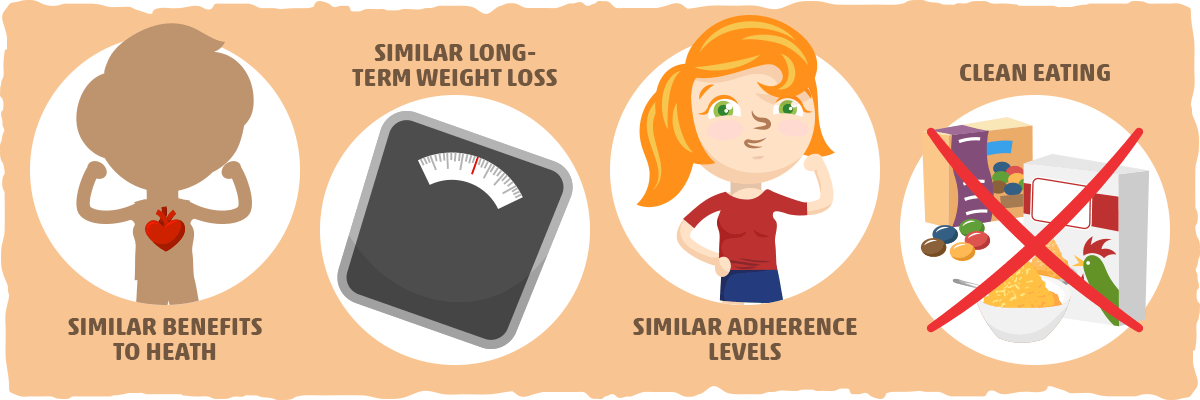
When we compare the keto diet and Mediterranean diet to westernized diets, many similarities arise that help us understand why these two vastly different approaches can both improve health substantially.
The four similarities worth noting are:
- They benefit similar aspects of health. Both diets, when compared to westernized low-fat diets, help us improve several important biomarkers for overall health, such as cholesterol, triglycerides, blood sugar, and blood pressure levels.
- They provide us with similar long-term weight loss results. Although the keto diet typically yields more weight loss in the short-term, studies indicate that both diets achieve similar weight loss after 1-2 years.
- They both have similar adherence levels. Although the keto diet looks more restrictive than the Mediterranean diet on paper, research indicates that it has roughly the same drop-out rates as other diets in dietary intervention trials (at around 24%). This may suggest that diet adherence depends more heavily on individual differences than on how much a diet restricts specific foods or macronutrients.
- They both are biased toward “clean eating.” Both keto and Mediterranean diets tend to avoid all heavily processed foods and derive most of their calories from minimally processed, high-quality whole foods. This simple shift in food quality is one of the critical factors responsible for the many health benefits these diets have in common.
The Keto Diet Vs. The Mediterranean Diet: Deciphering Differences
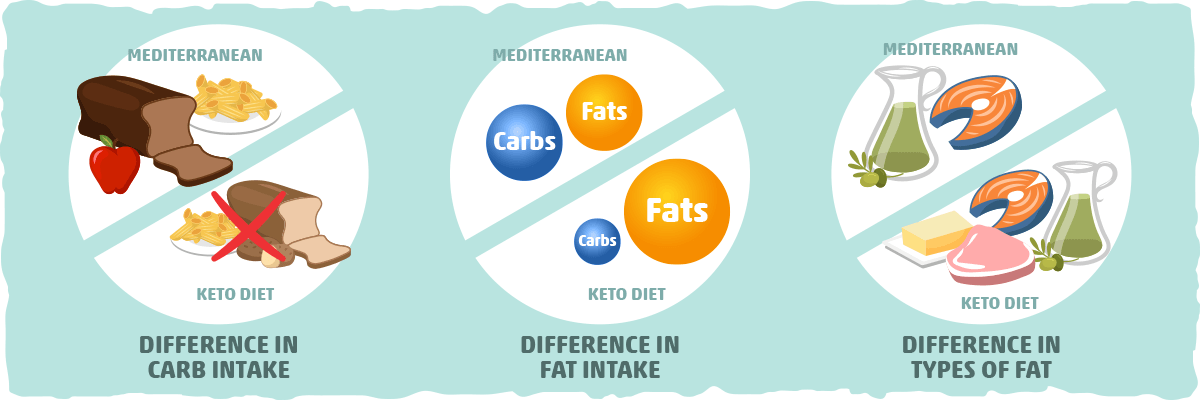
Although they share several common benefits, the ketogenic diet and the Mediterranean diet do have many noteworthy differences:
General Diet Differences
- Carb intake. The Mediterranean diet emphasizes healthy fats and eliminates refined sugars, but it also includes a moderately high amount of carbohydrates — including fruits and whole grain breads and pastas. In contrast, the ketogenic diet is always going to be very low in all carbohydrates, even from unrefined higher carb plant foods.
- Fat intake. The Mediterranean diet is higher in fat compared with standard low-fat diets, but it’s much lower in fat than keto. The primary source of calories on the keto diet is fat, while the primary source of calories on the Mediterranean diet is usually carbs.
- Type of fat consumed. The type of fat typically consumed on both diets is also different. The Mediterranean diet emphasizes natural unsaturated fats from plant-based oils and fish, while keto foods include copious amounts of saturated and unsaturated fats.
Keto Diet Advantages
The advantages that a standard keto diet has over a traditional Mediterranean diet are as follows:
- Potential to cause more significant reductions in triglyceride, blood sugar, insulin, and hbA1c levels.
- Greater increases in HDL cholesterol.
- Has been shown to aid in the treatment of Alzheimer’s disease, Parkinson’s disease, epilepsy, PCOS, type 2 diabetes, and some forms of cancer.
- Cuts out most binge-worthy foods.
- Can reduce appetite and calorie intake more than low-fat diets, making it a more sustainable long-term diet for many people.
Mediterranean Diet Advantages
The advantages of the Mediterranean diet include:
- Has more research supporting its health benefits and safety.
- Has been proven to reduce cardiovascular disease incidence and mortality.
- Focuses on more environmentally-friendly foods (i.e., more whole plant foods and less red meat and other animal products).
- Decreases LDL cholesterol levels significantly.
- Allows for the consumption of a wide variety of foods, reducing the risk of vitamin and mineral deficiencies.
Mediterranean Diet Downsides
However, the diet does come with some downsides:
- Incorporates a wide variety of foods that are easier to overeat, leading to an increased chance of fat gain.
- May not yield as remarkable differences in blood markers and body composition as a keto diet.
Keto Diet Downsides
Keto also comes with its share of potential disadvantages:
- Many first-time keto dieters experience the keto flu during the first few days.
- Greater risk of vitamin and mineral deficiencies if the diet is not well-formulated.
- People with hypothyroid or adrenal-related conditions may not respond well to carb restriction.
- People who have familial hypercholesterolemia may experience unhealthy changes in cholesterol levels after increasing their saturated fat consumption significantly.
Key Takeaways: The Keto Diet Vs. The Mediterranean Diet
To briefly summarize what we covered in the first half of this article, we put together a graphic with the most important points:
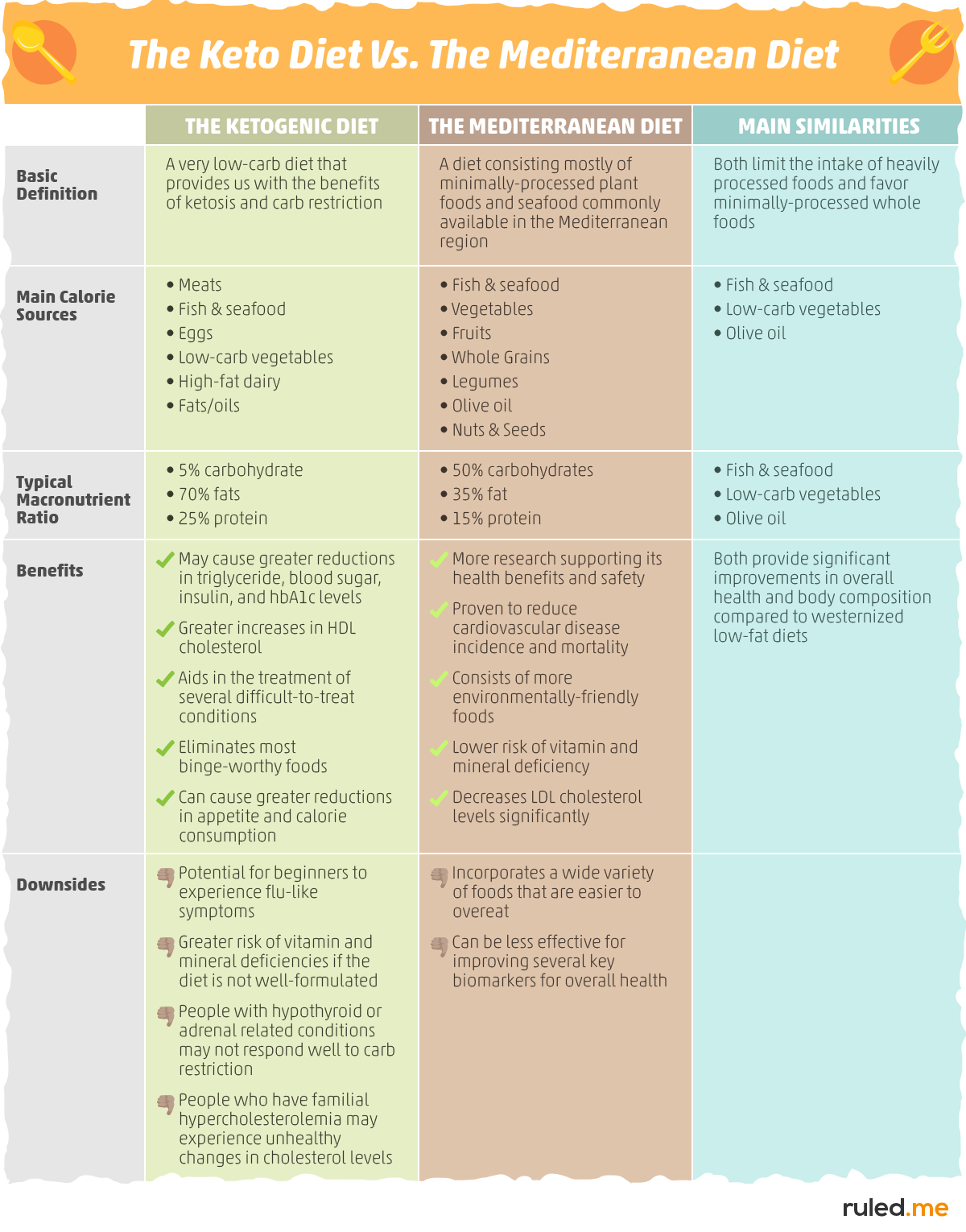
As you can see, both diets have the potential to vastly improve health, but each approach can be a better choice depending on the individual. Keto, for example, may help treat specific neurological conditions and can have a more substantial impact on many risk factors for type 2 diabetes and heart disease. In contrast, the Mediterranean diet may be may be a safer and healthier option for those who do not respond well to low carb diets or diets that are higher in saturated fat.
By pitting these two diets against each other, however, we are leaving an important question unanswered: What happens when we combine carb restriction and ketosis with Mediterranean foods? Let’s dig into the literature to find out.
The Case for the Mediterranean Ketogenic Diet: The Best of Both Worlds?
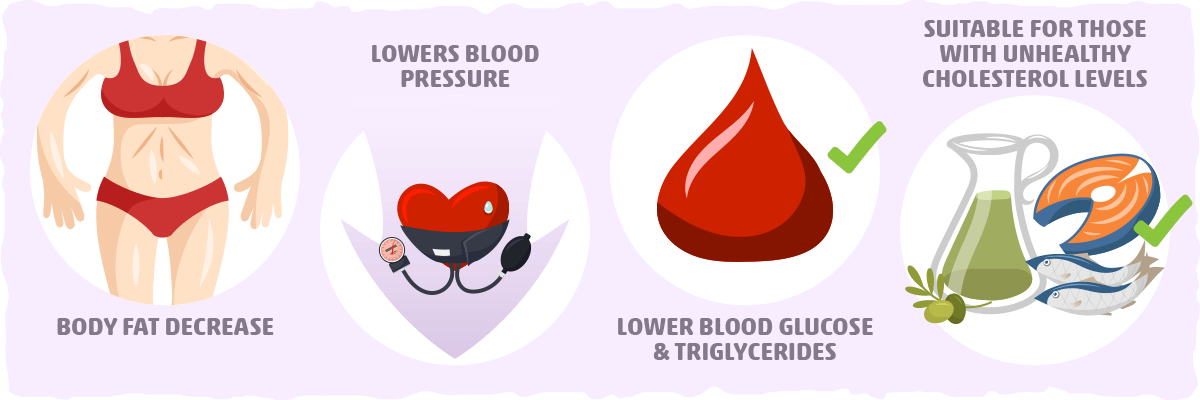
In 2008, researchers from Spain sought to explore the potential impact of combining the ketogenic diet with the Mediterranean diet. Their diet plan featured these primary characteristics:
- Unlimited calories (no calorie counting).
- Olive oil as the major source of added fat, with over 2 tablespoons consumed per day.
- Green vegetables and salads as the primary carbohydrate source.
- Fish was the major source of protein.
- Participants also drank a moderate amount of daily wine (200-400 ml/day).
The researchers called this a “Spanish Ketogenic Mediterranean diet,” and it resulted in changes you’d expected from a standard keto diet, including significant decreases in body fat, blood pressure, glucose, and triglycerides.
The most noteworthy finding, however, was what happened to each subject’s cholesterol numbers. On average, there was a reduction in LDL cholesterol (114.52 mg/dl→105.95 mg/dl) and an increase in HDL cholesterol (50.10 mg/dl→54.57 mg/dl).
In other words, the Spanish Ketogenic Mediterranean diet mitigated the increase in LDL cholesterol commonly experienced as a result of standard keto dieting while keeping its HDL boosting benefits. This indicates that consuming more unsaturated fat-rich foods like fish and olive oil and less saturated fat from other animal foods while restricting carbs may be a suitable strategy for those who struggle with unhealthy cholesterol levels.
A few years later, researchers conducted a similar study, exploring the effects of a six-week Mediterranean ketogenic diet with the addition of herbal extracts. Once again, the change in cholesterol levels was remarkable:
- Significant reductions in total cholesterol (204 mg/dl to 181 mg/dl)
- Significant decreases in LDL cholesterol (150 mg/dl to 136 mg/dl)
- Increases in HDL cholesterol (46 mg/dl to 52 mg/dl)
A more recent study, published in 2015, yielded similar results along with greater decreases in triglycerides, insulin, and inflammation levels when subjects followed the diet and supplemented with omega-3s from krill sources.
In summary, the current literature on the Mediterranean keto diet yielded similar results to what common sense would predict. This unique combination provides us with the benefits of both diets in one.
Key Takeaways: The Science-Backed Benefits of the Mediterranean Keto Diet
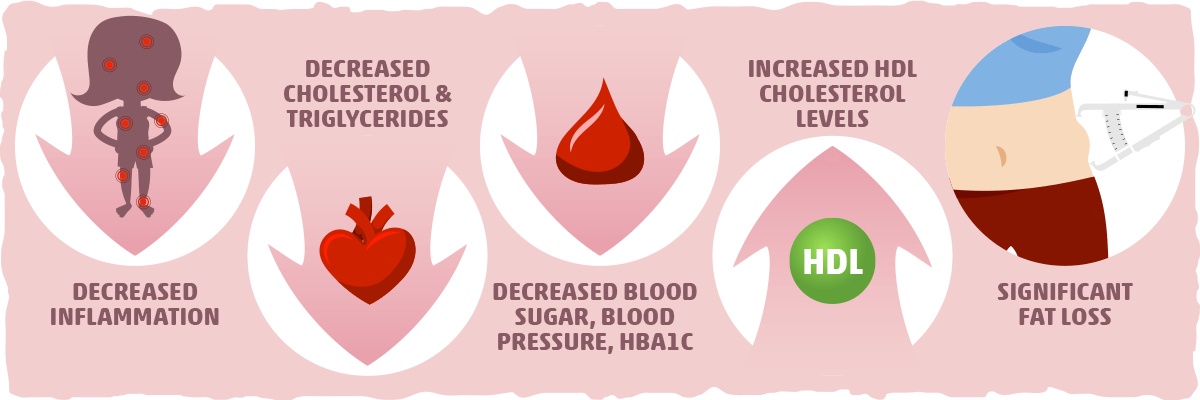
The current literature suggests that the combination of the Mediterranean and keto diet may provide more significant health benefits than either diet on its own. These science-backed benefits include:
- Decreased inflammation, total cholesterol, LDL cholesterol, triglyceride, blood sugar, insulin, blood pressure, and hbA1c levels
- Increased HDL cholesterol levels
- Significant fat loss
It is also reasonable to speculate that combining the key characteristics of each diet can also help us:
- Reduce cardiovascular disease incidence and mortality (as discovered through research on Mediterranean diets).
- Provide us with the unique benefits of ketosis and carb restriction (which you can learn more about in this article about the benefits of keto).
However, there is one crucial limitation to the current data on this diet: No studies have been conducted comparing the Mediterranean keto diet to the standard keto diet, Mediterranean diet, and/or a low-fat diet control group. This makes it difficult to determine how significant the differences are between each diet.
Despite this limitation, the current data does show us that the Mediterranean keto diet has the potential to optimize at least ten key biomarkers associated with heart disease, type 2 diabetes, and overall health all at once. This extends beyond what either the standard keto diet or the Mediterranean diet can help us achieve on their own.
To maximize these benefits, however, we must identify the primary principles responsible for the remarkable results. This will allow us to formulate a safe, simple, and highly effective Mediterranean keto diet.
What is the Mediterranean Ketogenic Diet?
No strict definition exists for the Mediterranean ketogenic diet. Even the research studies on this diet combination use slightly different variations.
However, there is enough data on each diet and their individual macronutrient components to identify the health-promoting aspects that every keto Mediterranean diet should have. These key characteristics include:
- Restrict carbs low enough to promote ketosis. Typically, total carbs should be below 35g and net carbs below 25g to stimulate ketone production and enter deeper levels of ketosis over time. This level of carb restriction can help reduce your appetite, boost weight loss, and significantly decrease your insulin, blood sugar, hbA1c, and triglyceride levels.
- Eat plenty of monounsaturated and polyunsaturated fats. You can do this by eating olive oil, avocados, and avocado oil instead of butter and coconut oil, replacing red meat with fatty fish, seafood, and fatty cuts of poultry, and snacking on low-carb nuts, seeds, and hard cheese instead of processed meats. These simple swaps will increase your consumption of fats that optimize cholesterol and triglycerides levels (more so than high-saturated fat foods). It may also be worth it to supplement with DHA+EPA to help decrease inflammation, insulin, and triglyceride levels if these are an issue for you.
- Get most of your carbs from keto-friendly vegetables. Eating plenty of leafy greens, colorful vegetables, and cruciferous vegetables is a must, with the goal of having them at every meal. These vegetables contain plenty of vitamins, minerals, and fiber to help optimize your health and prevent some common symptoms of the keto flu. However, many vegetables contain high levels of net carbs, so make sure you check our low carb vegetable list before incorporating them in your next keto meal.
- Use fish, seafood, poultry, and eggs as your primary protein sources. These protein sources are packed with protein, unsaturated fats, and other health-promoting compounds. Sustainably-caught wild salmon, sardines, and mackerel may be the best option because they are relatively high in omega-3s and more environmentally sustainable compared to other fish. Pasture-raised eggs and poultry are great options as well.
- Adjust your protein and fat intake based on your goals. Eating enough protein is what will help you preserve muscle or build it (if you are lifting weights), and manipulating your fat consumption is what will help you control your weight loss rate. To help you figure out good fat and protein intake goals to start with, I recommend plugging your info into our keto calculator.
These five criteria encapsulate the most important health-promoting components of the Mediterranean keto diet. For the sake of simplicity, we can even boil them down to one concise diet definition:
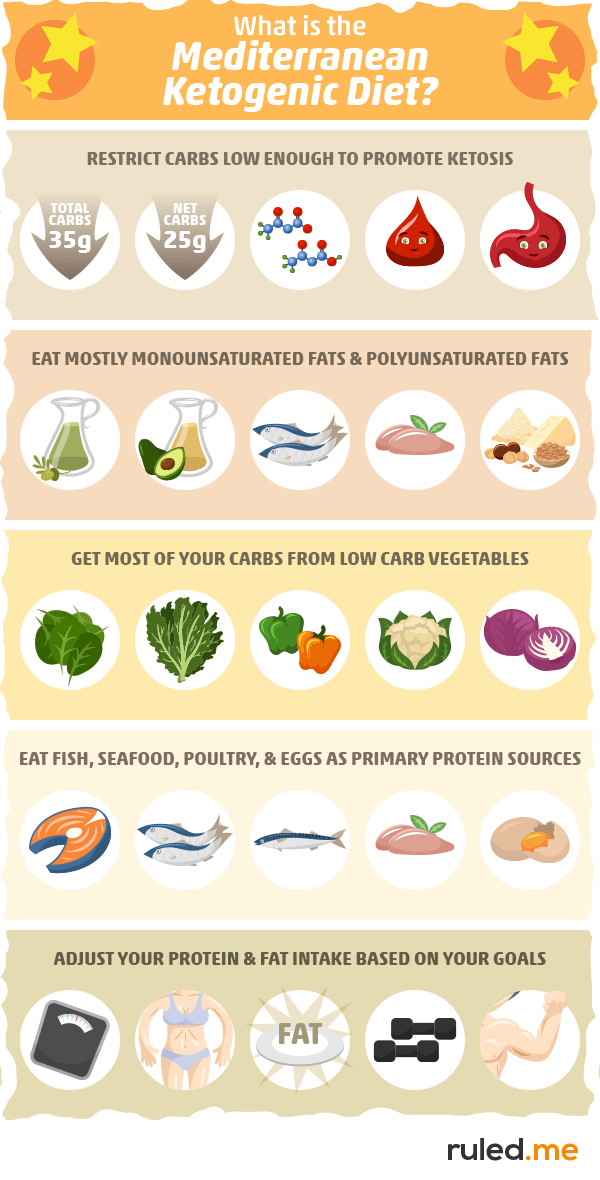
The keto Mediterranean diet combines standard keto diet macronutrient targets with common Mediterranean foods to provide us with the benefits of ketosis, carb restriction, natural unsaturated fats, and whole foods.
The Mediterranean Ketogenic Diet Food List
The Mediterranean keto diet primarily consists of these foods:
- Mediterranean protein sources — fatty fish, seafood, poultry, and eggs
- Fats/oils — olive oil, avocado oil, and MCT oil
- Low-carb vegetables — leafy greens, cruciferous vegetables, and other low carb veggies >
- Low-carb fruits — avocados, olives, and tomatoes
- Common Mediterranean flavorings — paprika, cumin, cinnamon, oregano, coriander, anise, Spanish saffron, lemon or lime juice, mint, parsley, garlic, etc.
Foods you can eat in moderation:
- Nuts and seeds — macadamia nuts, brazil nuts, pecans, flaxseeds, and chia seeds are the lowest carb options.
- High-fat dairy — hard full-fat cheeses, full-fat low-carb yogurt, heavy cream, etc.
- Low-carb fruits — low-carb berries, melon, and other low-carb fruits >
- Red meat — beef, pork, veal, lamb, etc.
- Saturated fat-rich fats/oils — coconut oil, butter, ghee, and animal fats
If necessary, limit these common keto foods to help lower LDL cholesterol numbers:
- Coconut oil
- Butter
- Heavy cream
- Fatty cuts of red meat
Foods to avoid:
- Grains – wheat, corn, rice, cereal, etc.
- Legumes — lentils, black beans, peas, etc.
- Sugar – honey, agave, maple syrup, etc.
- Fruit – apples, bananas, oranges, etc.
- Tubers – potato, yams, etc.
Choosing the Best Fish, Poultry, and Seafood for Your Keto Plate
When it comes to choosing the best option from the “Mediterranean protein source” category, we must consider two crucial factors:
- The percentage of fat, protein, and carbs in the fish, seafood, eggs, or poultry
- How much fat and protein you need to meet your daily intake goals
In general, we recommend opting for higher fat options over leaner cuts. To give you a better idea of the highest fat Mediterranean protein sources, we’ve included a list of the healthiest choices.
| Ingredient | % of calories from fat | % of calories from protein | Net carbs (g) | Notable benefits |
| Sardines, packed in EVOO | 0.6 | 0.4 | Trace amounts | ● Omega-3 fatty acids |
| ● Healthy fats | ||||
| ● Marine collagen | ||||
| ● Vitamin B12 | ||||
| ● Selenium | ||||
| Eggs | 0.6 | 0.33 | ~0.5 g in each large egg | ● Healthy fats |
| ● Vitamin A | ||||
| ● All B vitamins | ||||
| ● Choline | ||||
| ● Zinc | ||||
| Eel | 0.57 | 0.4 | Trace amounts | ● Healthy fats |
| ● Vitamin D | ||||
| ● Zinc | ||||
| ● Selenium | ||||
| ● Vitamin A | ||||
| Mackerel in EVOO, skinless & boneless | 0.55 | 0.45 | Trace amounts | ● Healthy fats |
| ● Omega-3 fatty acids | ||||
| ● Selenium | ||||
| ● Vitamin B12 | ||||
| ● Vitamin D | ||||
| King (chinook) salmon | 0.53 | 0.45 | Trace amounts | ● Healthy fats |
| ● Omega-3 fatty acids | ||||
| ● Vitamins B3, B5, B6 & B12 | ||||
| ● vitamin D | ||||
| ● vitamin E | ||||
| ● selenium | ||||
| ● High antioxidant content | ||||
| Confit duck leg with skin | 0.53 | 0.47 | Trace amounts | ● Healthy fats |
| ● Collagen protein | ||||
| ● Iron | ||||
| ● Selenium | ||||
| ● Vitamin B3 | ||||
| ● Vitamin B12 | ||||
| Herring | 0.52 | 0.46 | Trace amounts | ● Omega-3 fatty acids |
| ● Healthy fats | ||||
| ● Marine collagen | ||||
| ● Selenium | ||||
| ● Vitamin E | ||||
| ● Vitamin D | ||||
| ● Vitamin B12 | ||||
| Chicken thigh with skin | 0.51 | 0.47 | Trace amounts | ● Collagen protein |
| ● Healthy fats | ||||
| ● Vitamin B6, B3 & B12 | ||||
| ● Zinc | ||||
| ● Selenium |
Each one has more than 50% fat, less than 5% carbs, and plenty of health-promoting nutrients. That said, make sure to double-check the fat content before purchasing, as it will vary depending on the specific breed of animal, the animal’s diet, and the brand.
To increase the fat content of your keto plate to around 70%, simply pair one of the above high-fat protein sources with another high-fat keto food or high-quality fat/oil.
Your best bet is adding a serving of avocado, olives, low-carb nuts/seeds, or cheese to your meal. Not only will this boost its healthy fat content, but you’ll add more vitamins, minerals, and flavor as well.
On the other hand, if your daily fat intake is climbing too high, then a lower-fat Mediterranean protein source will be the better option:
- Duck breast with the skin: 45%
- Turkey leg with the skin: 42%
- Rainbow trout: 40%
- Chicken wings: 36%
- Sockeye salmon: 34%
- Pink salmon: 33%
- Skinless chicken breast: 20%
- Tilapia: 19%
- Seabass: 19%
- White meat turkey: 15%
- Shrimp, scallops, and crab legs: <15%
- Duck breast, without the skin: 13%
- Skipjack Tuna: 9%
- Cod: 8%
- Yellowfin tuna: 4%
We’ve organized this list of lower-fat cuts from highest to lowest fat content with the percentage of calories from fat next to each one.
As a general rule of thumb, try to get most of your fat and protein from fattier cuts of poultry, fatty fish, seafood, and eggs — Reserve the leaner options for days when you’ve already gotten plenty of fat from other keto foods.
To learn more about what it takes to make delicious keto Mediterranean meals with these ingredients, we’ve included several recipes and a sample meal plan below. You might be surprised at how simple this diet shift can be.
Mediterranean Ketogenic Diet Recipe Examples
These delicious keto recipes encapsulate the critical characteristics of Mediterranean keto. In the following section, you will find a 7-day meal plan featuring each recipe to achieve amazing results.
For Breakfast:
Low Carb Spicy Baked Eggs with Cheesy Hash
The combination of keto veggies with spicy and flavorful seasonings make this breakfast hash a winner. Feel free to add some extra avocado if you want more healthy fats to start your day.
These breakfast bombs are a great way to fit some extra omega-3s and health-promoting herbs into your diet. The hollandaise sauce gives it a nice flavor and creaminess, making it a Mediterranean keto favorite.
A quick, tasty breakfast that you can customize with your favorite keto toppings. Try adding some crushed pecans or macadamias for extra healthy fats and flavor.
Keto Zucchini Bread with Walnuts
This zucchini bread provides you with a delicious keto-friendly breakfast and plenty of healthy fats. Plus, it is just as good, if not better, than the real thing. All you have to do is replace the sugar with erythritol and regular flour with almond flour, and you’ll cut out the carbs without skimping on the flavor.
For Lunch:
Maple Shrimp Salad is a sweet and savory dish that can be served as a lunch entree or as a side salad for dinner. It really adds a unique twist to many traditional Mediterranean ingredients.
Salmon Lettuce Cups with Lemony Basil Spread
In just one lettuce cup, you can have a quick lunch with plenty of omega-3s, keto vegetables, and Mediterranean flavor. Each cup is filled with canned salmon, avocado, spicy purple onion, and a sprinkling of Parmesan. Then you can smear, slather, or dip your wrap in the undeniably delicious mayo spread comprised of fresh chopped basil, garlic, lemon juice, and mayonnaise.
One of the easiest ways to add more fat to your Mediterranean keto diet is by eating more avocados. This lunch recipe helps you do just that with a tasty keto egg salad serving as the perfect flavor booster.
This salad provides you with a delicious way to get some healthy fats, fiber, vitamins, and minerals. Feel free to use whatever greens you prefer (e.g., baby kale, arugula, and sweet baby lettuce). Double the serving or add some salmon or chicken on top for a more filling, protein-packed lunch.
For Dinner:
Low Carb Walnut Crusted Salmon
This salmon dish checks all the boxes for the keto Mediterranean diet. It is delicious, easy to make, and packed with healthy fats from the salmon, walnuts, and olive oil. You can’t go wrong with this keto dinner.
There is no need to drown in seafood while you are eating Mediterranean keto. This chicken pasta dish is a great way to switch up your protein source without missing out on the health benefits. Smoked paprika is the secret ingredient here that will give the chicken tenders a subtle smokey flavor, while simultaneously boosting the vitamin A and antioxidant levels of the whole meal.
This is almost as simple as you can get for a keto fish dish. It has loads of flavor, takes less than 15 minutes to get to the table, and you can serve it with any of your favorite keto sides.
Zucchini Ribbons & Avocado Walnut Pesto
The zucchini noodles in this dish are thin and tender, providing you with the perfect vehicle for transferring all of the delicious flavors of the avocado walnut pesto to your mouth. Feel free to add some chicken or salmon to make the dish more filling and protein rich.
For a Side Dish:
Roasted Celery and Macadamia Cheese
Did you know that, when roasted in the oven, celery turns buttery and sweet? Pair this with dairy-free macadamia cheese, and you’ve got yourself a fat-filled side dish that’s healthy and satiating.
A simple side salad for those who like to have some fresh greens with their meal. The fresh raspberries, crunchy pecans, and salty feta cheese really set this apart from other keto salads.
Fiesta Slaw with Avocado Lime Dressing
This fresh low-carb take on a family favorite combines the robust flavors of cilantro, avocado oil, and lime with a hearty, fiber-packed cabbage mix. The dressing in itself will provide you with plenty of monounsaturated fats, subtle notes of cumin, and a kick of chili powder.
All it takes to make this delicious side dish is preheating your oven, seasoning some broccoli, and stuffing it in the oven for some fantastic hands-off flavors to develop. Salty, cheesy, and lemony, with a bit of kick: what more could you want with a simple side dish?
For Dessert:
Cilantro Infused Avocado Lime Sorbet
The ingredients and appearance may fool you, but this is not guacamole. Although it has a subtle avocado taste, this keto lime sorbet is like the real thing without the sugar and packed with fat!
Pecan Softies with Sea Salt and Dark Chocolate
Looking for a delicious soft-baked cookie that is also keto-friendly? Look no further. These pecan softies are the perfect blend of nutty pecan flavor and dark chocolate that may become your new keto favorite.
Speculoos and Macadamia Biscotti
I’m always looking for an excuse to fit more macadamia nuts in my diet, and this twice baked, dry, crunchy biscotti is one of my favorites. A simple, yet delicious after-dinner keto treat.
Chocolate Chunk Avocado Ice Cream
Their creamy texture and health benefits make avocados the perfect ingredient for making healthy and delicious ice cream. Top with crushed nuts if you’d like to add some more fat.
7-Day Mediterranean Ketogenic Diet Meal Plan

Monday
- Breakfast: 1-2 slices of Keto Zucchini Bread with Walnuts (with keto-friendly peanut butter or homemade macadamia nut butter on top to increase fat intake)
- Lunch: 1 serving of Maple Shrimp Salad
- Dinner: 1 serving of Low Carb Walnut Crusted Salmon
- Side Dish: 1-2 servings of Lemon Roasted Spicy Broccoli
- Dessert (optional): pick any dessert from above and use it to fulfill your macronutrient needs.
Tuesday
- Breakfast: 1-2 servings of Low Carb Spicy Baked Eggs with Cheesy Hash
- Lunch: 1-2 servings of Salmon Lettuce Cups with Lemony Basil Spread
- Dinner: 1 serving of Chicken Tender Lazone
- Side Dish: 1 serving of Raspberry Pecan Salad
- Dessert (optional): pick any dessert from above and use it to fulfill your macronutrient needs.
Wednesday
- Breakfast: 1-2 servings of Vegan Keto Porridge
- Lunch: 2 servings of Spinach Watercress Keto Salad (if needed, top with fish or chicken to increase protein intake)
- Dinner: 1 serving of Zingy Lemon Fish
- Side Dish: 1 serving of Fiesta Slaw with Avocado Lime Dressing
- Dessert (optional): pick any dessert from above and use it to fulfill your macronutrient needs.
Thursday
- Breakfast: 1-2 servings of Salmon Benny Breakfast Bombs
- Lunch: 2 servings of Egg Salad Stuffed Avocado
- Dinner: 1-2 servings of Zucchini Ribbons & Avocado Walnut Pesto (if needed, top with fish or chicken to increase protein intake)
- Side Dish: 1-2 servings of Roasted Celery and Macadamia Cheese
- Dessert (optional): pick any dessert from above and use it to fulfill your macronutrient needs.
Friday
- Breakfast: the leftover serving of Low Carb Spicy Baked Eggs with Cheesy Hash with 1-2 slices of Keto Zucchini Bread with Walnuts (with keto-friendly peanut butter or homemade macadamia nut butter on top to increase fat intake)
- Lunch: 1 serving of Maple Shrimp Salad
- Dinner: 1 serving of Low Carb Walnut Crusted Salmon
- Side Dish: 1 serving of Raspberry Pecan Salad
- Dessert (optional): pick any dessert from above and use it to fulfill your macronutrient needs.
Saturday
- Breakfast: 1-2 servings of Salmon Benny Breakfast Bombs
- Lunch: 2 servings of Egg Salad Stuffed Avocado
- Dinner: 1 serving of Zingy Lemon Fish
- Side Dish: 1 serving of Roasted Celery and Macadamia Cheese
- Dessert (optional): pick any dessert from above and use it to fulfill your macronutrient needs.
Sunday
- Breakfast: 1-2 servings of Vegan Keto Porridge
- Lunch: 1-2 servings of Salmon Lettuce Cups with Lemony Basil Spread
- Dinner: 1-2 servings of Zucchini Ribbons & Avocado Walnut Pesto (if needed, top with fish or chicken to increase protein intake)
- Side Dish: 1-2 servings of Lemon Roasted Spicy Broccoli
- Dessert (optional): pick any dessert from above and use it to fulfill your macronutrient needs.
Please Note: This meal plan is meant to show you what a week of the keto Mediterranean meals may look like. This is not designed to fulfill your personal needs. Make sure you use the macronutrient breakdowns on the bottom of each recipe web page and our keto calculator to help you customize this plan for your goals.
Who Would Benefit Most from Switching to a Mediterranean Ketogenic Diet?
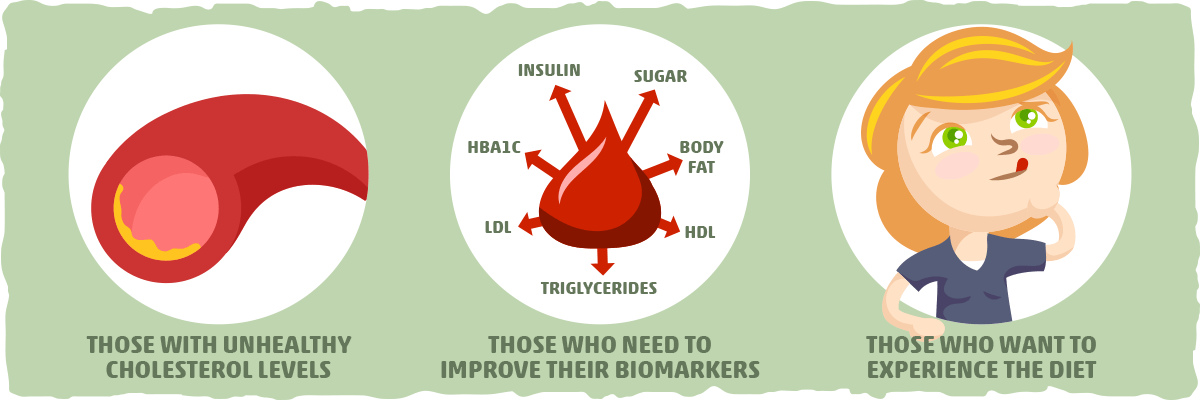
The paucity of research on how the Mediterranean keto diet affects different populations makes it difficult to determine who would gain the most from following this dietary approach. However, there is enough evidence to make a few speculations.
People who may benefit more from the Mediterranean keto diet vs. a standard keto diet are:
- Those who experience unhealthy increases in blood cholesterol levels after following the standard keto diet. Whether you have familial hypercholesterolemia or generally unhealthy blood cholesterol levels, a standard keto diet that substantially increases saturated fat consumption has the potential to make things worse. If standard keto isn’t having a positive impact, then swapping out some saturated fats for natural unsaturated fats by eating more keto-friendly Mediterranean diet foods may help optimize your cholesterol levels. To learn more about keto and cholesterol, click here.
- Those who need to improve multiple biomarkers. The Mediterranean keto diet has been shown to increase HDL, decrease LDL, and significantly reduce blood pressure, blood sugar, insulin, hbA1C, triglyceride, and body fat levels. If you are looking for a diet that can help you optimize any combination of these biomarkers, then Mediterranean keto may be the best choice for you.
- Those who want to experience the benefits of the Mediterranean diet, carb restriction, and ketosis. Want to get the best of both worlds? Give Mediterranean keto a try and see how you respond to the diet. Keep track of your health, wellbeing, and ability to stay with it. If you don’t respond well to the diet after 1-2 months, then adjust closer to a Mediterranean diet or a standard keto diet, whichever approach may be more sustainable for you, your lifestyle, and your health.
Mediterranean Diet vs. Keto Mediterranean Diet?
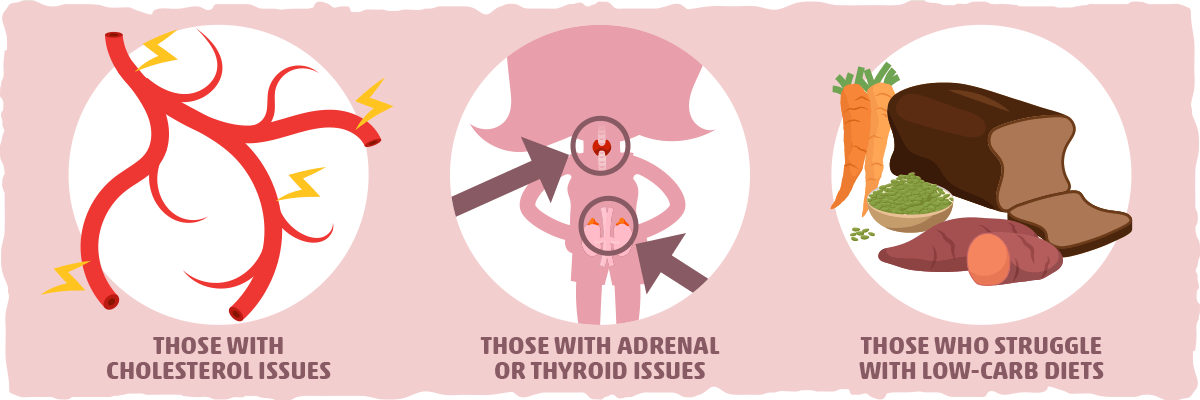
Although the Mediterranean keto diet provides us with most of the benefits of keto and the Mediterranean diet all in one, this doesn’t mean we should ignore the traditional Mediterranean diet altogether. In fact, a Mediterranean diet with moderate carbs may be the best option for some people.
Here are the three main instances when the Mediterranean diet may be the better option:
- For those who have familial hypercholesterolemia and don’t respond well to a Mediterranean keto diet. Even if we had dozens of studies on the topic, it would still be difficult to predict individual responses to the diet, especially for people who have familial hypercholesterolemia. Some may respond remarkably well to a Mediterranean keto diet, while others may need to lower their fat intake and increase their carb intake by eating more starchy veggies, legumes, and whole grains to keep their cholesterol levels under control. The only way to know what may be the heart-healthy approach for you is by testing blood cholesterol levels every 1-2 months.
- For those who have an adrenal or hypothyroid condition that does not respond well to carb restriction. Both the adrenal and thyroid glands need carbs to function optimally, so people who are already vulnerable to adrenal or thyroid issues may not respond well to keto diets. That being said, some people with specific thyroid issues, such as Hashimoto’s thyroiditis, may feel better on keto diets. This is why it is important to give the diet a 1-2 month test run to see what it does for your health and wellbeing.
- For those who struggle to stay on a carb-restricted diet. After giving the Mediterranean keto diet or standard keto diet a try, many find that it isn’t suitable for long-term dieting. If this is the case for you, then try converting to a low-to-moderate carb Mediterranean diet with more starchy vegetables, legumes, and whole grains. This diet can still help promote health and weight loss and may be a much better fit for you if you can stick to it and get results.
Key Takeaways for Mediterranean Keto: Principles, Benefits, and Practical Strategies
It wouldn’t be surprising if the Mediterranean keto diet starts to catch on in the coming years. This approach not only can provide us with the benefits of low-carb dieting and ketosis, but it may also come with the same heart health benefits as the Mediterranean diet.
Here’s a quick overview of what this unique diet combination may do for us:
- Decrease diastolic and systolic blood pressure
- Reduce blood sugar, triglycerides, hbA1c, and LDL cholesterol levels
- Increase HDL cholesterol
- Optimize overall cholesterol levels
- Improve stress levels and sense of well being
- Stimulate sustained fat loss
- Decrease heart disease mortality
- Reduce the incidence of coronary heart disease
- Decrease stroke incidence
- Decrease stroke mortality
- Decrease heart attack incidence
The diet principles responsible for most of these benefits are as follows:
- Restrict carbs low enough to promote ketosis.
- Adjust your protein and fat intake based on your goals (use our keto calculator to help you out).
- Eat mostly monounsaturated fats (olive oil, avocados, avocado oil, macadamia nuts, etc.) and polyunsaturated fats (especially omega-3s from fish and seafood).
- Get most of your carbs from low carb vegetables.
- Use fish, seafood, poultry, and eggs as your primary protein sources.
By following the above principles, you will be able to experience the Mediterranean keto diet and its potential benefits for yourself. As with any diet change, however, make sure you are monitoring your health and following an approach that you can turn into a long-term healthy lifestyle.
Give the diet a try for 1-2 months and monitor your health throughout the process. If you find the Mediterranean keto diet is not improving your health and wellbeing, then a non-keto Mediterranean diet with more high-carb plant foods may be a better option.
Before you get started on your keto journey, however, we recommend reading through our beginner’s guide, so you know what to expect as you are entering ketosis.
Sources
- The Mediterranean Diet — An Up-Close Look at Its Origins in Pantelleria — Today’s Dietitian
- Weight Loss with a Low-Carbohydrate, Mediterranean, or Low-Fat Diet — The New England Journal of Medicine
- Mediterranean diet, cardiovascular disease and mortality in diabetes: A systematic review and meta-analysis of prospective cohort studies and randomized clinical trials. – NCBI
- Adhering to the Ketogenic Diet – Is it Easy or Hard? (Research Review) — The Science of Fitness
- Strategies to Improve Adherence to Dietary Weight Loss Interventions in Research and Real-World Settings — NCBI
- The American Heart Association’s Diet and Lifestyle Recommendations – Heart
- Effects of Ketogenic Diets on Cardiovascular Risk Factors: Evidence from Animal and Human Studies – NCBI
- Cardiovascular disease risk factor responses to a type 2 diabetes care model including nutritional ketosis induced by sustained carbohydrate restriction at 1 year: an open label, non-randomized, controlled study – Cardiovascular Diabetology
- Dietary Intervention to Reverse Carotid Atherosclerosis – Circulation
- The National Cholesterol Education Program Diet vs a Diet Lower in Carbohydrates and Higher in Protein and Monounsaturated Fat: A Randomized Trial – JAMA Network
- Dietary patterns and the risk of major adverse cardiovascular events in a global study of high-risk patients with stable coronary heart disease – European Heart Journal
- Diet and Heart Disease—What Every Cardiologist Should Know – American College of Cardiology
- Long term successful weight loss with a combination biphasic ketogenic Mediterranean diet and Mediterranean diet maintenance protocol. – NCBI
- Effects of n-3 polyunsaturated fatty acids (ω-3) supplementation on some cardiovascular risk factors with a ketogenic Mediterranean diet. – NCBI
- Effect of ketogenic Mediterranean diet with phytoextracts and low carbohydrates/high-protein meals on weight, cardiovascular risk factors, body composition and diet compliance in Italian council employees. – NCBI
- Spanish Ketogenic Mediterranean diet: a healthy cardiovascular diet for weight loss – NCBI
- The Ketogenic Diet and Cholesterol — Ruled.me
- What Is the Best Triglyceride Lowering Diet? — Ruled.me


